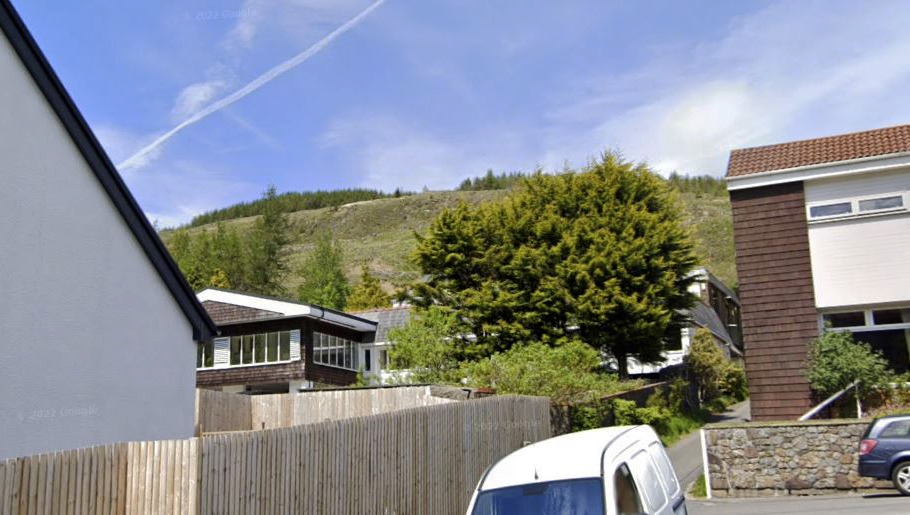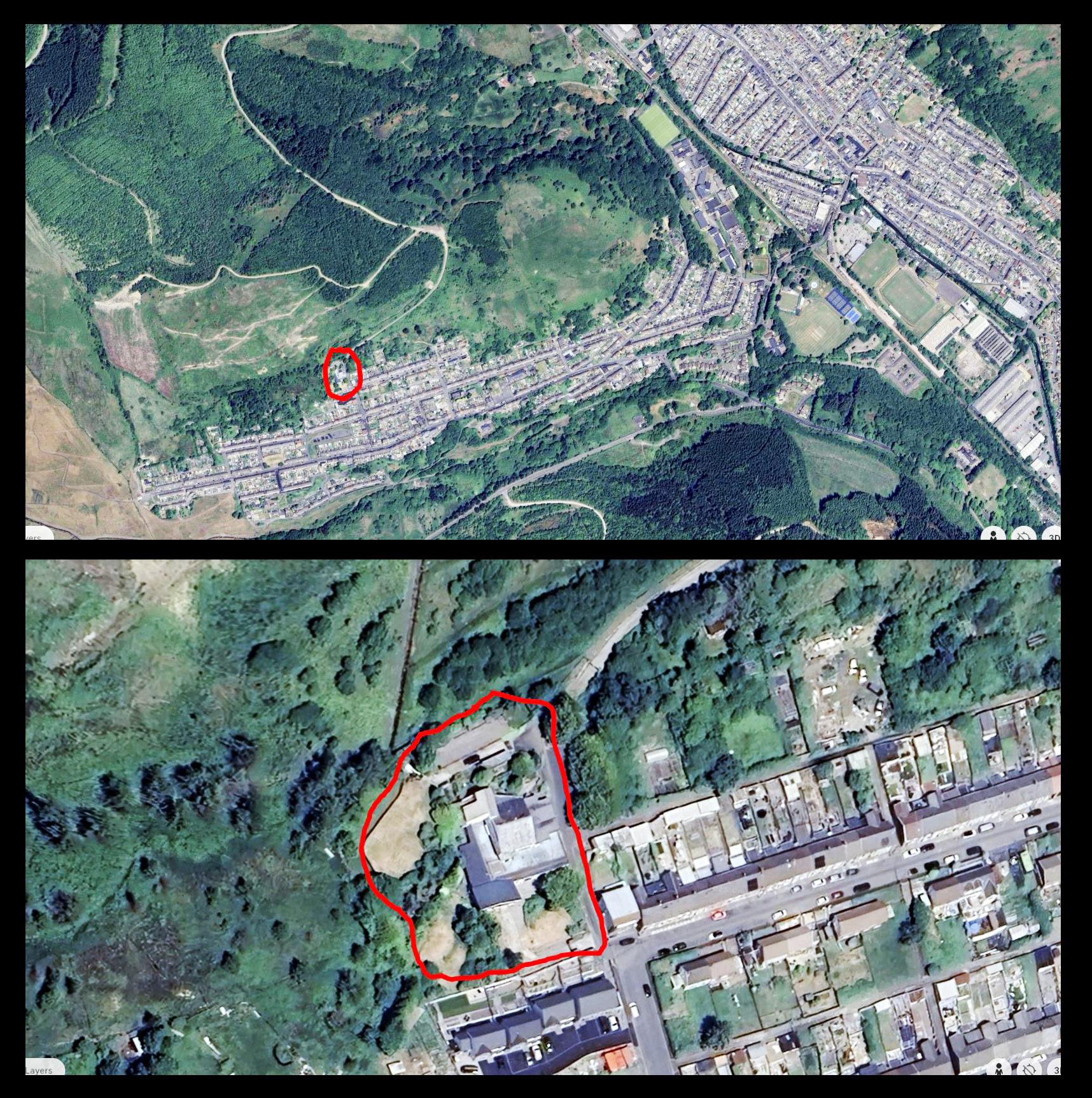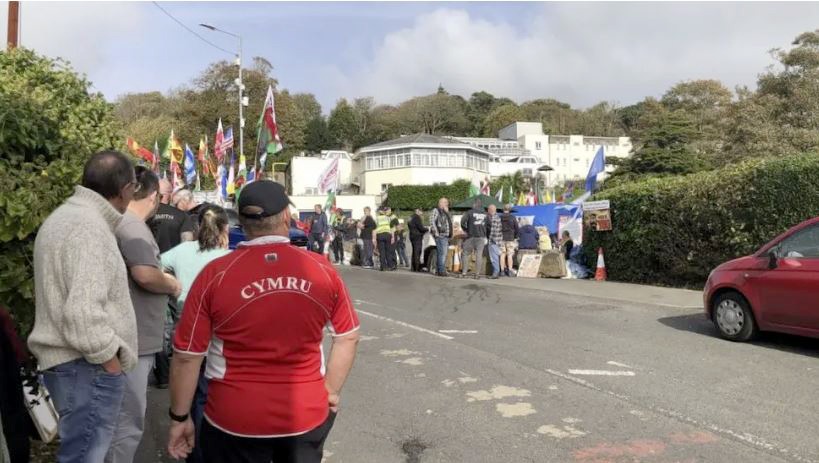![]() This is another ‘quickie’. It began life last week when someone made me aware of what’s happening in Cwmparc, Treorchy, a community in the Rhondda Fawr.
This is another ‘quickie’. It began life last week when someone made me aware of what’s happening in Cwmparc, Treorchy, a community in the Rhondda Fawr.
In a nutshell . . . the new owner of a substantial property at the end of a terrace had put up heavy gates, denying locals access to the mountain behind. Access they’d enjoyed for generations. After protests, the gates were removed, but then they returned, this time with guards in attendance.
◊
WHERE ARE WE?
Cwmparc lies in a side valley running west off the main valley. You can locate it in the maps below, with the property in question – 1 & 2 Ger-y-Coed – circled in red.

To help you further, here’s a Google image showing both properties (centre) before the gates were put in place, clearly showing the lower part of the contested access.

The properties were up for sale at the end of 2023. And sold early in 2024. The registered owner is Adam Lee Drew; certainly, his name is on the title documents. Though I’m not 100% convinced he is the owner.
Having mentioned title documents, I should explain there are quite a few relating to this plot. I only downloaded two because the Land Registry recently increased its prices. Which means a title document with plan now costs £14, up from £6.
(How the hell is anyone allowed to get away with a 133% increase?)
Anyway, here’s the first of the two titles I downloaded, WA212230, it covers some of the property including the debated access. And reads in part (dated 2016):
The registered proprietor claims that the land has
the benefit of a right of way with or without vehicles
over the land shown hatched in blue on the title
plan.
The land hatched in blue is the disputed access. Does what you read above infer there’s a public right of way?
The second, CYM398171, shows land lower down the hill, taking in one, possibly two, of these new houses. So I’m assuming the part boxed in green has been removed from the original title.
Soon after these titles were registered to him Drew became a director of a big Franco-US company by the name of Kyriba. A company registered with Companies House but headquartered in San Diego, California. I suspect Drew is CFO of Kyriba’s UK operation.
Before joining Kyriba, and according to his Linkedin profile, Drew worked for German outfit Suse.
◊
POSSIBILE EXPLANATIONS
I think there are three possible explanations for what’s happening at Vicarage Terrace.
First, access; it’s about the land above Cwmparc, land managed by Natural Resources Wales. And if that’s the case, then we could be looking at yet more wind turbines. Possibly even solar panels, for the Rhondda is globally renowned for the 16 hours of sunshine it enjoys every day.
But this makes little sense, for the access past Ger-y-Coed would never accommodate the kind of vehicles needed to transport turbines and blades.
Which doesn’t rule out wind turbines. Perhaps the gates are to deter locals from seeing the preparatory work being done up on the mountain. And if it is turbines, then a new road will have to be cut somewhere to take the vehicles I just talked about.
If this is what’s happening, then Adam Lee Drew is fronting for someone else.
The second possibility is the property itself, 1 & 2 Ger-y-Coed. A substantial layout that could easily house 40 or 50 single individuals. Maybe more, at a squeeze.

I’m referring now to young men with no good reason to be here, who are a threat to public safety and social cohesion, yet are welcomed by Globalist puppet politicians – for those very reasons!
If this is the plan, then it could be Drew taking the heat for someone else, or he could be flying solo.
The third possibility is that this is nothing more than the new owner of the property being bloody awkward. In which case, Rhondda Cynon Taf council needs to pull its finger out and immediately declare the contested access a public right of way.
In fact, RCT could do that no matter which of those suggestions is correct. Even if it’s something else entirely.
◊
GLOBAL SUPPORT FOR THE GATES, OR . . . ?
Maybe what made up my mind to put out this piece was the reactions I found on the Rhondda Leader Facebook page. To explain . . .
I’m in contact with a well-informed individual who told me that her father, in Treorchy, had heard nothing about the Cwmparc furore. So I Googled ‘Rhondda Leader’, the local weekly ‘paper.
There’s an X account, and a Facebook page; but on the X account, where I expected to find a link to the Rhondda Leader website, there was only a link to the Rhondda page of WalesOnline.
Of the six Cwmparc access articles on the Facebook page yesterday, one had 7 comments, one had 10, one 64, one 542, one 670, and this one 2,300 comments. Is this a record for the Rhondda Leader?
So I focused on the report that garnered most responses. And something started to strike me as odd. And that was so many comments supporting the actions of Adam Lee Drew in blocking off the access.
And in terms of their geographic spread, these comments came from northern Scotland all the way down to southern England, even from overseas – but few from anywhere near Cwmparc!
Then the closer I looked at these supportive comments, the iffier some of them looked. Here’s a small selection. And these were all found among the first few comments to the piece I just linked to.

I went to ‘Dyan Chamberlain’s FB account. What I found looks, well, ‘bare’. It seems to be a lot of stock photos. Is it genuine?
Another that caught my eye was the contribution from ‘Keith Jackson’

So, I checked out his FB account. It suggests that ‘Keith Jackson’, if he exists, lives in the land currently being liberated by President Trump and his team. (Glory to them!)
There was even a supportive comment from an ‘Alan Barsteward‘. Which drew applause from ‘Chris Mutch‘, who claims to live in Cardiff.

I was drawn to the third by the Welsh name.

And again, I went to the FB account. Where I encountered this!

As I say, I don’t know a lot about Facebook, and I only scratched the surface of the comments. But I saw enough to suggest there’s an organised campaign to support Adam Drew, his gates and his guards.
But who’d organise such a campaign over a dispute between neighbours? It suggests there might be rather more to those gates, and the guards, doesn’t it?
Latest news is that there was a protest yesterday, and there was a good turnout considering the bad weather.
◊
CONCLUSION
As I was writing this, I slowly dismissed the idea of Drew, a Rhondda boy, buying these properties, to live in himself, surrounded by neighbours he’d pissed off.
What’s panning out tells me he won’t be living there. Which takes us on to the other options – ‘renewables’ and housing illegal aliens.
The first I also dismiss for the reasons given above. The remaining possibility made me think of an earlier example.
Cast your mind back to events at the Stradey Park Hotel in Llanelli a while ago. Almost 100 staff were sacked because the Home Office wanted to bring in over 200 ‘asylum seekers’, all young men.
There was near-unanimous opposition. Though politicians and media tried to discredit worried locals by claiming those protesting were ‘far right’ and ‘outsiders’.

Stradey Park Hotel was an eye-opener for anyone who still believed in politicians, or trusted the media. Thankfully, the locals won.
One factor I’m sure was that, from a security perspective, the Llanelli site was on a busy road, making it too accessible. It was almost impossible to keep protesters away.
Not so at Cwmparc. At Ger-y-Coed it would be easy to restrict and control access. In fact, Cwmparc itself could be sealed with a couple of choke points.
If I’m right, then someone in Corruption Bay, and also at RCT council, knows what’s planned. (And it’s why I’ve submitted a FoI to the Home Office.)
So let’s have openness. Because too much of what happens in Wales is hidden from us by politicians and civil servants who, at the macro level, serve Globalists and their corporate friends, helping them exploit and wreck Wales.
At the micro level, priorities are determined by pressure groups, composed of leftists, anti-white racists, ‘environmentalists’, sexual deviants, and some who can only be labelled – and I say this without wishing to offend – certifiable fucking nutters.
So let’s have some uncharacteristic honesty from a corrupt political class and its scheming bureaucracy – tell us what’s planned for Ger-y-Coed in Cwmparc.
If they won’t do the decent thing then, instead of asking concerned locals how many different ways they can say, ‘Ooooh, isn’t it awful!’, let our media redeem themselves.
UPDATE 27.02.2025: This report just appeared in WalesOnline. The owners (un-named) claim that a number of problems — basically, anti-social behaviour – left them no option but to install the gates.
Observations:
It’s reasonable to assume that these issues would have been reported to the police, the council, local politicians, Natural Resources Wales. The owners might even have reached out to the local community in Cwmparc. Did they?
Even if the claims are true, 3m high solid fencing, motorised gates, and guards, seems like an over-reaction to what was after all just anti-social behaviour. And a very expensive reaction!
♦ end ♦
© Royston Jones 2025









